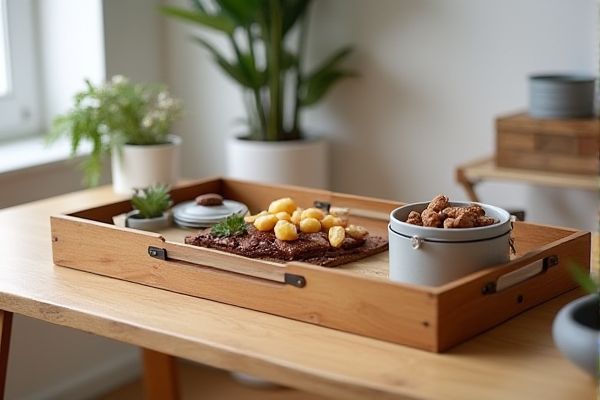
A portable tray offers flexibility and ease of movement, making it ideal for multitasking in various locations, while a fixed tray provides stability and a permanent solution for consistent use. Discover which option best suits Your needs and enhances your workspace by reading the rest of this article.
Table of Comparison
| Feature | Portable Tray | Fixed Tray |
|---|---|---|
| Mobility | Easy to move and reposition | Stationary and permanently installed |
| Installation | No installation required | Requires professional installation |
| Space Usage | Space-saving, flexible use | Occupies dedicated space |
| Durability | Less durable, lightweight materials | Highly durable, sturdy construction |
| Cost | Generally lower cost | Higher initial cost |
| Maintenance | Easy to clean and maintain | Requires occasional maintenance |
| Use Cases | Ideal for temporary setups and flexible workspaces | Best for permanent workstations and heavy-duty tasks |
Introduction to Portable and Fixed Trays
Portable trays offer mobility and flexibility, making them ideal for dynamic work environments and on-the-go tasks. Fixed trays provide stability and durability, commonly used in permanent setups like dental or laboratory workstations. Your choice between portable and fixed trays depends on whether you prioritize ease of transport or a steady, reliable workspace.
Design and Material Differences
Portable trays feature lightweight, durable materials such as aluminum or plastic, allowing easy transport and flexibility in placement, while fixed trays typically use sturdier materials like stainless steel or hardwood for enhanced stability and long-term use. Design-wise, portable trays often incorporate foldable or detachable legs for compact storage, whereas fixed trays are integrated into furniture or countertops, emphasizing permanence and robustness. The material and design choices directly impact usability, with portable trays favoring mobility and fixed trays prioritizing strength and durability.
Ease of Installation
A portable tray offers exceptional ease of installation, allowing quick setup without the need for permanent fixtures or structural modifications, making it ideal for temporary or flexible workspace solutions. Fixed trays require more complex installation processes involving secure mounting and alignment, often demanding professional assistance and longer setup times. Your choice depends on the balance between convenience and long-term stability in your cable management needs.
Portability and Flexibility
Portable trays offer superior portability and flexibility, enabling users to easily move and adjust their workspace according to changing needs or environments. Fixed trays, while providing stable and sturdy support, lack mobility and are typically limited to one designated location. The choice depends on whether convenience and adaptability or permanence and stability are prioritized.
Space and Storage Considerations
Portable trays offer enhanced flexibility by allowing easy relocation and compact storage when not in use, making them ideal for limited spaces. Fixed trays require dedicated, permanent space due to their installation, which can limit room utilization but provide a stable surface for continuous tasks. Choosing between portable and fixed trays hinges on balancing the need for mobility against the availability of consistent floor or countertop areas.
Durability and Maintenance
Portable trays offer flexibility but often compromise on durability due to frequent handling and potential wear from movement, requiring more regular maintenance to prevent damage and ensure stability. Fixed trays, securely attached to furniture or fixtures, provide superior durability with less risk of breakage or loosening, minimizing maintenance needs and offering long-term reliability. You can maximize tray lifespan by choosing fixed options for sturdy, low-maintenance use or portable trays for versatility, paired with consistent upkeep.
Cost Comparison
A portable tray typically costs less upfront compared to a fixed tray due to its simple design and ease of installation. Fixed trays often require higher initial investment because of permanent mounting and durable materials, leading to increased labor and material expenses. You should consider long-term maintenance and replacement costs when deciding between portable and fixed trays, as portability often reduces ongoing expenses.
Best Use Cases for Portable Trays
Portable trays offer unparalleled versatility and convenience, making them ideal for environments requiring frequent repositioning such as classrooms, hospitals, and outdoor events. Their lightweight construction and compact design allow for easy transport and storage, enhancing productivity in dynamic workspaces. These trays are best suited for tasks involving temporary setups, mobile workstations, or situations where space optimization is critical.
Ideal Applications for Fixed Trays
Fixed trays are ideal for long-term, consistent use in environments like dental laboratories and industrial settings where precise, stable support is essential. They provide enhanced durability and accuracy for repeated tasks, making them suitable for applications such as impression taking and prosthesis fabrication. Their rigid structure ensures minimal distortion, which is critical for high-quality, repeatable results.
Choosing the Right Tray for Your Needs
Portable trays offer flexibility and convenience, making them ideal for users who need to move or adjust their workspace frequently. Fixed trays provide stability and durability, suitable for environments where a permanent setup is preferred. Assess your daily tasks and workspace constraints to determine if a portable or fixed tray best supports your workflow and comfort.
 homyna.com
homyna.com